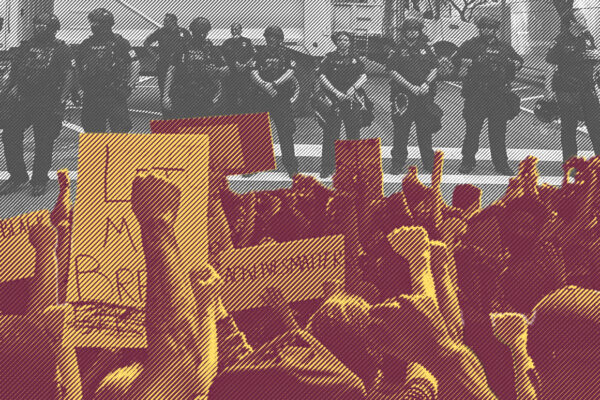On May 31, less than one week after the murder of George Floyd, who grew up in Texas and was killed by a Minneapolis police officer in broad daylight, the Dallas Police Department’s (DPD) Twitter feed blandly reported “76 individuals arrested and jailed and approximately 45 to 60 more being processed to go to jail.”
Those individuals’ alleged crime? Protesting George Floyd’s murder and police brutality against Black lives.
The situation in Dallas quickly escalated. The DPD released more information, this time that the department was “investigating two cases of police use of force that [landed] two people in the hospital.” Later, during the evening of June 1, the DPD surrounded approximately two hundred protesters, many of them Black and brown youth, on the Margaret Hunt Hill Bridge.
The protesters say they were effectively “kettled” on the bridge while marching — directed onto it by police on one end, then confronted by another line of police blocking the other side. The DPD, joined by National Guard troops, pummeled the crowd with rubber bullets and smoke in attempts to corral the largely peaceful group.
Instead of backing down against the escalated police response, hundreds of thousands of people have taken to the streets to peacefully protest from coast to coast. And in Texas, from Houston to El Paso, stories of heavily-armed police forces escalating tensions and using violent tactics to respond to protesters have been packing social media feeds. Police departments throughout Texas have been using tear gas and pepper spray, a Houston officer on horseback was seen trampling a young, Black female protester, and a 20 year old in Austin is in critical condition from “less lethal” police weapons.
In response to the expression of collective pain over another murder of a Black person at the hands of overly-militarized police forces and racial injustice, police departments are responding with excessive use of force against crowds comprised largely of people of color. Unsurprisingly, research has shown increasing force is one of the worst responses policing agencies can utilize during protests of any kind.
That’s why we sent a letter to local leaders across Texas calling for immediate deescalation of over-militarized policing tactics against protesters statewide and the safeguarding of protesters’ constitutional rights by utilizing 10 basic principles. Dissent and protest are fundamental parts of our democracy, and peaceful protesters should be allowed to do just that, peacefully protest, without fear of aggressive arrest let alone hospitalization.
Where there’s thunder there’s lightning, and in the case of Mr. Floyd’s murder, the thunder has been rumbling in Black and brown communities for a long time. People are tired of being ignored, and they’re tired of Black and brown lives being treated as disposable.
This is not a case of “a few bad apples,” and suggesting so erases the pain of countless families who have lost their loved ones to police brutality. The murder of George Floyd and the violence against protesters in Texas and across the nation is reflective of a police system that has been unaccountable for too long.
There are ways that you can support the Movement for Black Lives, the protesters who have been arrested, and protesters’ rights in speaking out against police brutality against Black lives. Visit our resource page to learn more about Texas-based bail funds and Black-led justice organizations throughout the state. You can also easily access our Know Your Rights information on your right to protest and how to film police to share with those in your community.




